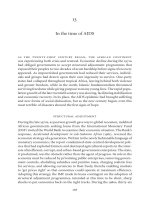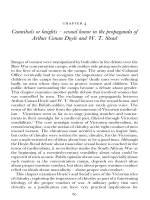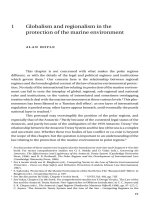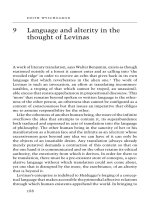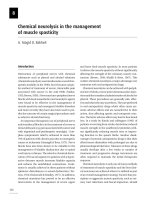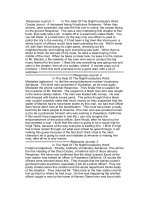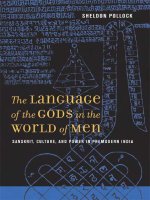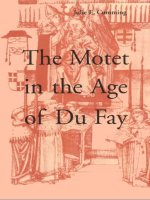In the time of AIDS
Bạn đang xem bản rút gọn của tài liệu. Xem và tải ngay bản đầy đủ của tài liệu tại đây (4.03 MB, 28 trang )
P1: RNK
0521864381c13 CUNY780B-African 978 0 521 68297 8 May 15, 2007 16:41
13
In the time of AIDS
as the twenty-first century began, the african continent
was experiencing both crisis and renewal. Economic decline during the 1970s
had obliged governments to accept structural adjustment programmes that
exposed their peoples to two decades of acute hardship before signs of recovery
appeared. As impoverished governments had reduced their services, individ-
uals and groups had drawn upon their own ingenuity to survive. One-party
states had collapsed throughout tropical Africa, leaving behind both violence
and greater freedom, while in the north, Islamic fundamentalism threatened
surviving freedoms while giving purpose to many young lives. The rapid popu-
lation growth of the late twentieth century was slowing, facilitating stabilisation
and economic recovery. In its place, the AIDS epidemic had brought suffering
and new forms of social dislocation, but as the new century began, even this
most terrible of disasters showed the first signs of hope.
structural adjustment
During the late 1970s, as postwar growth gave way to global recession, indebted
African governments seeking loans from the International Monetary Fund
(IMF) invited the World Bank to examine their economic situation. The Bank’s
response, Accelerated development in sub-Saharan Africa (1981), reversed the
economic strategy of a generation. Written in the newly fashionable language of
monetary economics, the report condemned state-centred development poli-
cies that had exploited farmers and destroyed agricultural exports in the inter-
ests of inefficient, corrupt, and urban-based government enterprises. The state,
it proclaimed, was the obstacle rather than the agent of progress. Its role in the
economy must be reduced by privatising public enterprises, removing govern-
ment controls, abolishing subsidies and punitive taxes, charging realistic fees
for services, and allowing currencies to float freely, thereby enabling markets
to ‘get prices right’ so that economies could operate at maximum efficiency.
Adopting this strategy, the IMF made its loans contingent on the adoption of
structural adjustment programmes, intended at this time to be short, sharp
shocks to put economies back on the right tracks. During the 1980s, thirty-six
288
P1: RNK
0521864381c13 CUNY780B-African 978 0 521 68297 8 May 15, 2007 16:41
In the time of AIDS 289
15.Inthe time of AIDS.
P1: RNK
0521864381c13 CUNY780B-African 978 0 521 68297 8 May 15, 2007 16:41
290 africans: the history of a continent
of the forty-seven countries in sub-Saharan Africa and nearly all of those in
the north formally adopted such programmes. Their effects varied widely.
Twoofthe most positive experiences were in Ghana and Uganda. Under
Nkrumah and his successors, Ghana had epitomised state-centred develop-
ment strategies and its economic growth had fallen far behind population
increase. By 1981 its industry was running at one-quarter of capacity, cocoa
output was only one-third of its earlier peak, and one-fifth of all Ghanaians
were outside the country, ‘voting with their suitcases’. In that year young rad-
icals led by Flight-Lieutenant Jerry Rawlings seized power in a military coup
with socialist objectives. Within two years, they had switched to a structural
adjustment programme of austerity and market liberalisation that made Ghana
the IMF’s flagship. The reasons for their change of strategy included their good
sense, the sheer desperation of the country’s plight, the insistence of the inter-
national financial institutions, the lack of practicable alternative policies, the
bankruptcy of vested interests that might have opposed reform, and the absence
of electoral democracy during the regime’s first eleven years. Its initial step was
to devalue the currency by over 98 percent. By the late 1980s, liberalisation
of cocoa marketing had doubled producer prices and output. Civil service
employment was halved and tax revenue doubled. The annual growth of Gross
Domestic Product rose from 1.4 percent in 1965–80 to 3.0 percent in 1980–90,
4.2 percent in 1990–2001, and 4.8 percent in 2000–4.
1
These were modest figures
and not everything was successful. In 1998 real GDP per capita was still lower
than it had been in 1970. Ghana’s old and unproductive cocoa trees struggled
to compete with plantations outside Africa. Manufacturing employment fell
by nearly two-thirds between 1987 and 1993 as protection against imported
goods was withdrawn. The restoration of elections from 1992 led to ‘demo-
cratic demand inflation’ as governments expanded the money supply to win
votes, the currency depreciated, and debt rose by 1998 to three times its level
in 1981.The short, sharp shock became a seemingly permanent condition, but
economic decline was at least reversed.
Uganda’s experience was similar. General Amin’s regime and the subsequent
civil war had reduced per capita GDP by 42 percent between 1971 and 1986,
when President Museveni’s National Resistance Movement (NRM) took power.
Afterabrief experiment with radical policies had brought the economy close to
collapse, the NRM adopted a structural adjustment programme, which vested
interests were too weakened to resist. The currency was devalued by 76percent,
the heavy taxation on coffee exports that had financed previous regimes was
abolished, export volume grew at 15 percent per year during the 1990s, producer
prices multiplied three or four times, the civil service was halved, the share of tax
revenueinGDP doubled, and the annual increase in real GDP between 1986
and 1999 averaged 6.3 percent. In 1996 the IMF declared Uganda’s economy
the most open in Africa. As in Ghana, the price was dependence. During the
P1: RNK
0521864381c13 CUNY780B-African 978 0 521 68297 8 May 15, 2007 16:41
In the time of AIDS 291
1990s, Uganda received nearly $5 billion in foreign aid, which financed between
one-third and two-thirds of public expenditure. Privatisation fostered rampant
corruption. Yet the recovery was real and GDP continued to grow during the
early 2000sat5.8 percent per year.
2
The most surprising convert to liberalisation was the new ANC govern-
ment in South Africa. When it took power in 1994,real per capita GDP had
declined during the previous 21 years by anaverageof0.6 percent per year.
3
To
reverse this and begin to rectify massive economic inequalities, the new regime
adopted a five-year Reconstruction and Development Programme (RDP)
designed to achieve growth through redistribution, with provision to nation-
alise commanding heights of the economy, redistribute 30 percent of agricul-
tural land, and build a million new houses. By 1996,however, there was little
sign of recovery and it was becoming clear that this first attempt to restructure
an industrial economy, without a prior social revolution and within a domi-
nant world capitalist system, must take much longer than radical nationalists
had dreamed. Instead, GDP was just keeping pace with population growth and
employment was falling rapidly as government pruned its payroll, goldmin-
ing contracted, commercial farmers reduced workforces, major firms moved
their headquarters to Europe, and liberalisation of the exchange rate in 1996
led to a rapid fall in the value of the rand. South Africa was not yet at the
IMF’s mercy, but its leaders clearly resolved that stabilisation must temporar-
ily have priority over transformation. In 1996,without consultation, they
replaced the RDP by a new strategy, Growth, Employment, and Redistribution
(GEAR), which abandoned nationalisation, acceleratedprivatisation,restricted
public expenditure, reduced import tariffs to stimulate competitiveness,
encouraged foreign investment and labour market flexibility, promoted
exports, and prioritised growth over redistribution. When the eagerly mod-
ernising Thabo Mbeki became president in 1999,heinsisted ‘that we aban-
don our embarrassment about the possibility of the emergence of successful
and prosperous black owners of productive property.’
4
The chief beneficia-
ries of the new regime were indeed middle-class Africans, whose numbers
rose at an estimated 21 percent per year between 1993 and 2003.Thechief
losers were the unskilled, for although GEAR promised to create 600,000 jobs
over five years, South Africa actually lost 500,000 during that period, chiefly in
government, agriculture, and goldmining. The Confederation of South African
Trade Unions mounted three general strikes against the GEAR programme
during 2000–2. Only in the mid-2000s did unemployment show the first
signs of decline. By then, moreover, GDP growth at about 4 percentper
year was outrunning a nearly stable population, partly owing to a new surge
in gold prices. ANC leaders tacitly abandoned GEAR, shelved privatisation,
planned to expand public investment, and resumed their redistributive ambi-
tions, spending heavily on old-age pensions and child-support grants and
P1: RNK
0521864381c13 CUNY780B-African 978 0 521 68297 8 May 15, 2007 16:41
292 africans: the history of a continent
requiring that one-quarter of mining and industrial assets and 30 percent of
agricultural land should pass into African hands within a decade. While rad-
ical observers complained that the ANC had ‘squandered an opportunity of
world-historic proportions’, its leaders replied that ‘carefully measured actions
and studied moderation’ had ‘helped reassure skittish investors and interna-
tional markets’, ensuring ‘a decade of social peace underpinned by political
stability.’
5
Elsewhere in the continent, structural adjustment provoked varied responses
and effects. In North Africa, economic liberalisation from above tended to
strengthen political authoritarianism, notably in Tunisia, which implemented
its own successful programme and enjoyed steady if unspectacular growth. In
Egypt, by contrast, policy fluctuated between Sadat’s hasty liberalisation of the
1970s, which brought rapid growth and massive foreign debt, and Mubarak’s
grudging response to international financial pressures. Both regimes were
especially reluctant to privatise state enterprises underlying their economic
and political power, a reluctance even stronger in Algeria, whose government
insisted on retaining ownership of the oil and gas industries, which in the mid
1990sprovided97 percent of foreign exchange earnings. North Africa’s strate-
gic importance curbed the IMF’s reforming zeal, but there was less restraint in
Central Africa, where the impact of structural adjustment was perhaps most
damaging. Zambia’s acute economic crisis, caused chiefly by the collapse of
world copper prices during the 1970s, obliged it to negotiate an adjustment
programme in 1983, but unlike Ghana and Uganda its unpopular government
had been in power for twenty years, the programme did not provide foreign
exchange to support liberalisation, the currency sank by 90 percent in two years,
and the IMF insisted on the removal of food subsidies for the 45 percent of
Zambians living in towns. The result was strikes and urban riots, the govern-
ment’s collapse, and further economic decline to the end of the century. Even
more damaging was the programme devised in 1991 for Zimbabwe’s relatively
successful economy. By opening its industries to South African competition,
structural adjustment reduced manufacturing output by 21 percentinfour
years, exports declined, unemployment rose, debt increased sharply, and when
world tobacco prices also fell at the end of the decade, the regime took refuge
in an expropriation of surviving European farms, which devastated agricul-
tural production. Between 2000 and 2004,Zimbabwe’s GDP probably declined
by about 30 percent, the currency lost 99 percent of its value, and perhaps
three-quarters of the population were reduced to poverty.
6
It would be wrong to exaggerate the power that international financial insti-
tutions could exert over African governments. Most rulers recognised that
structural reform threatened their revenue, patronage, and freedom of action,
‘like telling the people to rise against us’, as President Stevens of Sierra Leone
complained. Some, like Senghor in Senegal and Nyerere in Tanzania, refused
P1: RNK
0521864381c13 CUNY780B-African 978 0 521 68297 8 May 15, 2007 16:41
In the time of AIDS 293
to implement adjustment programmes. Others obstructed them, as in Kenya,
or reduced them to cosmetic gestures, as in Cameroun. Everywhere certain
liberalising measures, such as floating the currency, were easier to implement
than others, notably privatisation, which not only threatened vested interests
but often meant either transfering national assets to political favourites at bar-
gain prices or selling them to foreign investors, notably the South African
conglomerates that took the opportunity to buy most of sub-Saharan Africa’s
mining enterprises and many banking, brewing, retailing, electricity, and air-
line companies. One study of IMF programmes found that only about half were
completed during the loan period,
7
but once the international institutions had
committed funds, they could do little but continue lending in the hope of
eventual success, for their own reputations were tied to the policy. Controversy
surrounding it gradually obliged them to shift their ground. Whereas Acceler-
ated development had insisted in 1981 on reducing the role of the state, by 1997 –
in the face of state collapse in countries like Somalia and Sierra Leone – the
World Bank detected ‘a crisis of statehood’ in Africa and stressed the need to
extend state capacity,
8
recognising that effective response to liberalising stimuli
often needed state backing and even state entrepreneurship. Two years later,
the international institutions replaced structural adjustment programmes by
PovertyReduction Strategy Papers, which were three-year plans to be drawn
up by recipient governments in consultation with local business interests, trade
unions, and nongovernmental organisations before submission for the donors’
approval. The aim, according to the head of the IMF, was ‘to teach a society,
not just a government, how to live within its means’.
9
By the beginning of the new millennium, no African state had yet emerged
from the structural adjustment process, while the IMF, the paragon of financial
prudence, was massively overlent to African governments. Yet there were signs
of recovery. Whereas sub-Saharan Africa’s annual growth rate of GDP had fallen
from its high level of 4.8 percent in 1965–80 to only 1.7 percent in 1980–90 and
2.6 percent in 1990–2001, between 2000 and 2004 it rose again to 3.9 percent,
well above the population growth rate of 2.2 percent.
10
Whether this signified
lasting improvement, and whether structural adjustment was responsible for
it, was not yet clear.
state contraction andculturalchange
As economic decline and structural adjustment cut into public revenue, state
services contracted and society, always the true strength of African civilisation,
adapted to new conditions as it had in the past adapted to the slave trade or colo-
nial rule. Education best illustrated this process. Most nationalist leaders had
owed their positions to schooling and had invested massively in it. Between 1960
and 1983,primary school enrolment in black Africa had roughly quadrupled,
P1: RNK
0521864381c13 CUNY780B-African 978 0 521 68297 8 May 15, 2007 16:41
294 africans: the history of a continent
secondary school places had multiplied sixfold, and the number of university
students had increased twenty-fold.
11
It had beenoneofthegreat achievements
of independence, with important political implications. Thereafter, however,
education systems faltered as the ever-expanding child population pressed on
diminishing resources. University education, although often expensive and
declining inquality,wasstill coveted as a qualification for employment. Between
1994 and 2000,Makerere University in Uganda expanded its enrolment from
seven thousand to twenty-two thousand students. Secondary school enrolment
also continued to rise. Primary schooling, by contrast, gave little advantage in
employment unless it led on to the secondary level. When primary education
was made free, as in Uganda in 1997 and Kenya in 2003, there was a massive
increase in enrolment, but in Tanzania, where in 1991 only 5 percent of primary
school leavers gained entry to public secondary schools, primary enrolment
fell between 1981 and 1997 from 94 to 67 percent of the age group.
12
Yet many
parents, convinced that education was the chief means of advancement open to
their families, responded by providing their own schools, especially at the sec-
ondary level. By 1995 those in Tanzania outnumbered state secondary schools.
Many were runbychurches, but some Islamic regions organised similar private
systems, even in Egypt. Kenya was one of many countries where profit-making
schools proliferated.
Health care followed a similar pattern. Between the 1960s and the mid-1980s,
the increase in medical personnel, together with cheap drugs, immunisation
procedures, and general development, had reduced infant mortality by nearly
one-third and spared Africa any major epidemic. These medical interventions
were so powerful that their impact continued, less dramatically, through the
1980sonacontinental scale, but the impact waned in areas of violence, famine,
and extreme economic decay. Ghana’s real per capita public expenditure on
health fell by 60 percent between 1974 and 1984;eight years later the country
had some fifty thousand cases of yaws, a disease of poverty supposedly eradi-
cated before independence, and its child mortality rate had risen. Tuberculosis,
cholera, and yellow fever became more prevalent, while at the end of the century
perhaps half a million Africans contracted sleeping sickness each year and one
in six suffered a clinical case of malaria. To these was added the AIDS epidemic.
Life expectancy at birth in sub-Saharan Africa had risen from 42 years in 1965 to
apeakof53 years in 1996;by2003 it had fallen again to 46 years.
13
As state med-
ical systems were overwhelmed, many Western-trained doctors took refuge in
private practice. Popular responses included buying modern drugs from prolif-
erating retail outlets, consulting traditional practitioners, and adding modern
drugs to local pharmacopoeia in Africa’s characteristically eclectic manner.
Access to effective medicine depended increasingly on wealth, so that infant
mortality rates varied more widely with income in cities like Abidjan than they
had even in nineteenth-century Europe.
P1: RNK
0521864381c13 CUNY780B-African 978 0 521 68297 8 May 15, 2007 16:41
In the time of AIDS 295
This did not halt migration to towns, although it had slowed since the 1960s
and now focused on provincial centres rather than capitals. During the 1980s
and 1990s, sub-Saharan Africa’s townsmen increased twice as fast as its popula-
tion, forming 34 percent of the total in 1999 and nearly twice that proportion in
South Africa. Some of the most rapid migration was by those fleeing rural dislo-
cation, notably in Tanzania and Mozambique. The ANC government in South
Africa built or subsidised nearly two million new housing units during its first
twelve years in power, but elsewhere public housing provision lost all contact
with need, so that the poor clustered either into single rooms at extortionate
rents or into the self-built family shacks on city fringes known in Nouakchott
as ‘refuse dumps’. Whereas urban wages had far exceeded rural earnings during
the 1960s, they fell over 30 percent on average during the 1980s. Yet employ-
ment was still a privilege, because the poor, hitherto mainly the incapacitated,
now included the able-bodied unemployed. Statistics in the early 1980sgener-
ally showed them as 8 to 15 percent of the potential urban labour force, but
the proportion grew thereafter, reaching some 25 percent in Kenyan cities and
40 percent in South Africa in 1996, the latter figure inflated by the lack of viable
peasant agriculture. Yet even these figures were misleading because many of the
poor could not afford to be unemployed and instead undertook ‘occupations’
with minute earnings. The totally unemployed were mostly young people still
relying on family support. Over half of Algerians in their early twenties were
unemployed in the late 1980saspopulation growth and education outstripped
jobs. Street gangs like the Ninjas of Lusaka and Talibans of Nairobi flourished.
In 1988 one of every five Nigerian prisoners was a teenager. An anthropologist
studying the Zambian Copperbelt at that time found ‘an overwhelming sense of
decline and despair’ as expectations of working lives in a modern environment
were dashed.
14
Survival in decaying cities depended heavily on informal occupations, which
employed some 72 percent of Nigeria’s urban labour force in 1978, including its
innumerable women traders and youthful apprentices. Even in South Africa,
where the authorities had long repressed informal enterprise, it had expanded
by 2000 to generate an estimated 28 percent of GDP. Self-employed earnings
could be relatively high, but employees in the sector were severely exploited
and many young men began their working careers in unpaid jobs. Informal
occupations merged into the ‘second economy’ of black-marketeering, smug-
gling, corruption, and crime, which expanded as state power contracted. These
activities commonly relied on ethnic and family ties. Private schools, informal
enterprises, illicit trading diasporas, vigilante forces in place of nonexistent
police, and urban welfare associations in lieuofineffective trade unions all
mobilised ethnic solidarities, as did the continental passion for football. Within
the family, elite women had generally enhanced their status since political
independence, except in North Africa where fundamentalism reversed earlier
P1: RNK
0521864381c13 CUNY780B-African 978 0 521 68297 8 May 15, 2007 16:41
296 africans: the history of a continent
gains. All adult women had commonly gained the vote and in some coun-
tries, including Uganda and South Africa, they exercised significant political
influence. In 2006 Liberia elected the continent’s first woman president. Some
urban working women also gained greater equality within their families as
informal enterprise and female employment expanded while male earnings in
formal employment contracted. Peasant women, on the other hand, suffered
severely as a result of economic decline and the increasing pressure of popula-
tion on land. And all women, particularly the young, were especially vulnerable
to AIDS.
Religion was a further nexus of social solidarity, but it was also probably the
chief perspective through which Africans thought about their often threatening
world. Christianity and Islam spread widely as people hitherto excluded – espe-
cially women and remote communities – claimed places in the modern world.
‘Everybody had joined’, one woman explained, ‘and I was left behind like a fool’.
One estimate was that between 1950 and 1990 African Christians increased from
34 million towards 200 million.
15
The most rapid expansion was in Kenya and
Zimbabwe, in the rapidly growing cities, and in the Sudanic region running
from Senegal to Ethiopia. Many southern Chadians and Sudanese accepted
Christianity during resistance to northern domination, while conflict between
expanding Christian and Muslim fundamentalists bred grave conflict in cen-
tral Nigeria. Church hierarchies were rapidly Africanised. In 1993 the Roman
Catholic Church had sixteen African cardinals. At the Lambeth Conference
of the Anglican Church five years later, African bishops outnumbered their
British counterparts by three to two. Missionaries and money continued to
flow into the continent, especially from North America, while African voca-
tions increased rapidly at the end of the century as competition for secular
employment intensified. Yet Christian numbers nevertheless outran pastoral
capacity, fostering a peasant Christianity in the Ethiopian manner with strong
village congregations, sparsely trained evangelists, little superstructure or influ-
ence on family life, much partly Africanised ritual, and much eclectic survival
of indigenous practices.
The expanding independent churches – thought to number up to ten thou-
sand in the late 1980s–often had similar structures. A few had become major
hierarchical institutions, notably the Kimbanguist Church in the Democratic
Republic of the Congo and the Zion Christian Church in South Africa, but
most were very small, providing supportive communities, spiritual protec-
tion and healing, and personal empowerment amidst economic austerity and
state contraction. Some of the newest churches also held strongly millenar-
ian beliefs, especially perhaps in western Uganda where the AIDS epidemic
was acute. ‘This chastisement He released ...the world calls it AIDS dis-
ease...butfromtheLorditisapunishment’, leaders of the Movement for
the Restoration of the Ten Commandments of God told their followers before
P1: RNK
0521864381c13 CUNY780B-African 978 0 521 68297 8 May 15, 2007 16:41
In the time of AIDS 297
killing over a thousand of them in March 2000 as they awaited their promised
‘new generation’.
16
The need for certainty amidst the malaise and intellectual confusion sur-
rounding late twentieth-century Africans may explain the most remarkable
Christian phenomenon of the time: the explosive growth of pentecostal
churches, which had first reached South Africa early in the century but spread
throughout sub-Saharan Africa from the 1970s. By 2000,some24 percent of
all Ghanaians claimed to be pentecostalists. These churches characteristically
stressed personal salvation through repentance and the empowering baptism of
the Holy Spirit. Unlike earlier independent churches, they rejected the African
pastin favour of a globalising modernity. Oneimpetus, especially in WestAfrica,
came from well-financed American missionaries who taught the ‘prosperity
gospel’ that God would reward in this world those who first gave generously to
Hiswork, a teaching congruent with indigenous expectations of this-worldly
benefits from religion. Even pentecostal churches rejecting this teaching nev-
ertheless often appealed to upwardly mobile young urban Africans by display-
ing modernity and internationalism, stressing individualism and the nuclear
family, condemning corruption, and offering enticing prospects of success.
Ruralpentecostalism, likewise, might champion an austere morality that
denounced polygyny, drink, patriarchal domination, witchcraft, and indige-
nous religious practices as works of the Devil.
This radical dualism, reminiscent of early North African Christianity, was
the distinctive feature of pentecostalism. It pictured the world as a battleground
between, on the one side, God and his born-again faithful, and, on the other,
Satan, the witches, the old gods, and those who had sold their souls for wealth
and political power. At one level, this bred a luxuriant demonology displayed
in video films and articulated by an official Kenyan enquiry into devil-worship,
which reported satanic cults with cannibalistic initiation rites, blamed them
for rail and car crashes, and recommended the screening of religious organisa-
tions, a ban on music in minibus taxis (notorious arenas for dissent), and the
censorship of televised wrestling programmes.
17
At another level, pentecostal-
ism offered a critique of the state and social order as radically corrupted that
was psychologically satisfying to those who thought of politics in moral terms.
Dualism did not necessarily divide communities irremediably. As an anthro-
pologist noted, ‘People operate with black-and-white contrasts, but only to
create ever more complex new patterns.’
18
Yetdualism did pervade other
attempts to comprehend the forces that Africans felt acted upon them. One
feature of the late twentieth century was the intense concern with which both
the powerful and the powerless regarded witchcraft. Nervous authorities in
many regions prosecuted suspected witches, relying upon diviners for ‘expert’
testimony. Villagers were more likely to kill their suspects by mob action.
Similarly, Islam not only shared Christianity’s numerical growth but displayed
P1: RNK
0521864381c13 CUNY780B-African 978 0 521 68297 8 May 15, 2007 16:41
298 africans: the history of a continent
acomparable dualism, most strikingly in fundamentalism – as will be seen
later – but also in millenarian protest such as that launched by the hetero-
dox teacher, Muhammadu Marwa, who created a ‘private republic’ of young
rural immigrants in Kano, ‘preaching that anyone wearing a watch, or riding
abicycle, or driving a car, or sending his child to the normal State Schools was
an infidel.’
19
Its dispersal by the military in 1981 cost some four thousand lives.
That was the most violent protest in a postcolonial city. In normal circum-
stances, the urban poor, while resenting corruption and the gulf between ‘us’
and ‘them’, were too vulnerable, divided, dependent on patronage, committed
to ruralvalues, and aware of recent social mobility to challenge their rulers
openly. Religious zealots might bring them into the streets. So occasionally
might organised trade unionists, as in the Three Glorious Days that destroyed
Brazzaville’s government in 1963.Somight the breakdown of order during a
coup d’
´
etat, as in the orgy of looting in Nairobi in 1982.Themost common
urban disturbance was the ‘IMF riot’ against increased food prices, often due to
the removal of subsidies decreed by a structural adjustment programme. Such
riots brought down regimes in Liberia, Sudan, and Zambia and threatened
several others. Less often, but with greater brutality, urban crowds might turn
against the enemy within, as in Kinshasa in 1998,whentownspeople responded
to Rwandan invasion by massacring available Tutsi, or in Abidjan in 2004,
when crowds revenged themselves on French people and property after ‘peace-
keepers’ had destroyed the Ivoirian airforce. Abidjan’s disturbances were the
work of ‘young patriots’, the militant youths whose counterparts had idolised
Nkrumah, liberated Zimbabwe and Uganda, and destroyed apartheid. In less
violent circumstances, most late twentieth-century African cities had distinct
youth cultures blending indigenous traditions with the coveted modernity of
global fashions. The boys Dakar of the 1990s, for example, cultivated a bul faale
(play it cool) ethos valorising hard work and urban sophistication, advocated
sopi (political change), spoke a Franco-Wolof argot peppered with American,
listened avidly to iconoclastic rap, and idolised a champion wrestler from their
milieu known as Tyson. Products of rapid population growth, educated for
unemployment, unable to gain married adulthood by traditional means, and
denied the rapid social advancement their fathers had enjoyed, they were avail-
able for change, whether creative or destructive.
The youth cultures were not the only groups that challenged the social
order established at independence. Philosopher-presidents from Senegal and
Tanzania had long been obliged to share the OAU with sergeants and street
politicians. Now, as government revenues dwindled, official salaries shrivelled,
and informal enterprises expanded, social preeminence often passed from the
´evolu´e to the am´ericain who had made good as a migrant businessman in
the West, or even to the moodu moodu, the wealthy but uneducated trader.
Even Western-trained medical doctors, the ‘cream of the cream’ among the
